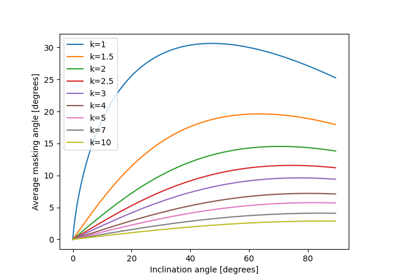pvlib.irradiance.isotropic#
- pvlib.irradiance.isotropic(surface_tilt, dhi)[source]#
Determine diffuse irradiance from the sky on a tilted surface using the isotropic sky model.
\[I_{d} = DHI \frac{1 + \cos\beta}{2}\]Hottel and Woertz’s model treats the sky as a uniform source of diffuse irradiance. Thus, the diffuse irradiance from the sky (ground reflected irradiance is not included in this algorithm) on a tilted surface can be found from the diffuse horizontal irradiance and the tilt angle of the surface. A discussion of the origin of the isotropic model can be found in 2.
- Parameters
surface_tilt (numeric) – Surface tilt angle in decimal degrees. Tilt must be >=0 and <=180. The tilt angle is defined as degrees from horizontal (e.g. surface facing up = 0, surface facing horizon = 90)
dhi (numeric) – Diffuse horizontal irradiance in W/m^2. DHI must be >=0.
- Returns
diffuse (numeric) – The sky diffuse component of the solar radiation.
References
- 1
Loutzenhiser P.G. et al. “Empirical validation of models to compute solar irradiance on inclined surfaces for building energy simulation” 2007, Solar Energy vol. 81. pp. 254-267 DOI: 10.1016/j.solener.2006.03.009
- 2
Kamphuis, N.R. et al. “Perspectives on the origin, derivation, meaning, and significance of the isotropic sky model” 2020, Solar Energy vol. 201. pp. 8-12 DOI: 10.1016/j.solener.2020.02.067
